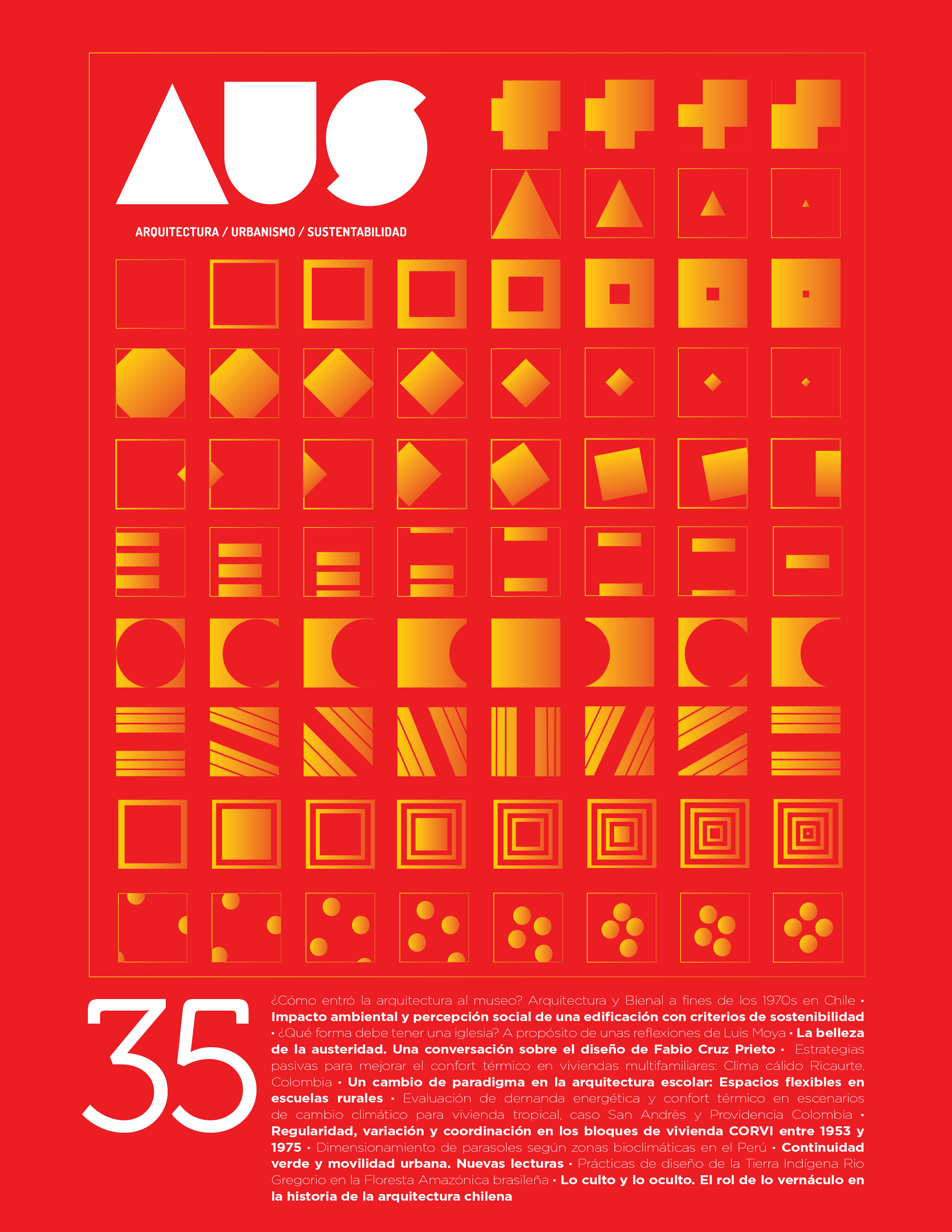Dimensionamiento de parasoles según zonas bioclimáticas en Perú
Contenido principal del artículo
Resumen
La protección solar exterior es una de las estrategias bioclimáticas más importantes en climas cálidos y templados cuyo fin es evitar el sobrecalentamiento interior y la consecuente falta de confort térmico de los ocupantes. El presente documento pretende identificar objetivamente los momentos del año y del día cuando se debe considerar la protección solar, en función del clima y de la latitud en la que se emplaza el edificio en el territorio peruano. El procedimiento no solamente permite reconocer las orientaciones ideales y ayudar en el dimensionamiento del parasol, sino que ha logrado evidenciar la necesidad de recuperar la cultura del sombreamiento de los vanos en gran parte de un territorio particularmente diverso y singular como el peruano
Detalles del artículo

Esta obra está bajo una licencia internacional Creative Commons Atribución-NoComercial-SinDerivadas 4.0.
Referencias
Agüero, R. (2009). El balcón y la celosía, elementos de confort lumínico y térmico en el clima de la ciudad de Lima. Tesis de maestría. Universidad Politécnica de Cataluña.
Al-Tamimi, N. y Fadzil, S. (2011). The potential of shading devices for temperature reduction in high-rise residential buildings in the tropics. Procedia Engineering 21: 273-282. https://doi.org/10.1016/j.proeng.2011.11.2015.
Brown, G. Z., y DeKay M. (2013). Sun, wind, and light. New York: Wiley.
Campbell, G. S., y Norman J.M. (2000). An introduction to environmental biophysics. Springer Science & Business Media.
De Dear, R., y Brager G.S. (1998). Developing an adaptive model of thermal comfort and preference. UC Berkeley: Center for the Built Environment. https://escholarship.org/uc/item/4qq2p9c6.
Evola, G., Gullo F., y Marletta L. (2017). The role of shading devices to improve thermal and visual comfort in existing glazed buildings. Energy Procedia 134: 346-355. https://doi.org/10.1016/j.egypro.2017.09.543.
Givoni, B. (1998). Climate considerations in building and urban design. John Wiley & Sons.
Humphreys, M., Nicol F., y Roaf S. (2015). Adaptive thermal comfort: foundations and analysis. Routledge. https://doi.org/10.4324/9781315765815.
Kirimtat A., Koyunbaba B., Chatzikonstantinou I., Sariyildiz S. (2016). Review of simulation modeling for shading devices in buildings. Renewable and Sustainable Energy Reviews 53: 23-49. https://doi.org/10.1016/j.rser.2015.08.020.
Lechner, N. y Andrasik P. (2021). Heating, Cooling, Lighting: Sustainable Design Strategies Towards Net Zero Architecture. John Wiley & Sons.
Ministerio de Vivienda, Construcción y Saneamiento. (2014). “Norma EM. 110 Confort Térmico y Lumínico con Eficiencia Energética”. Reglamento Nacional de Edificaciones. Lima, Perú.
Ministerio del Ambiente. Servicio Nacional de Meteorología e Hidrología (SENAMHI). (2022). Datos hidrometeorológicos a nivel nacional. Lima, Perú. https://www.senamhi.gob.pe/?&p=estaciones.
Miró Quesada, L. (2003). Introducción a la teoría del diseño arquitectónico. Editorial El Comercio S.A.
Nicol, J. F. y Humphreys M. A. (2002). Adaptive thermal comfort and sustainable thermal standards for buildings. Energy and buildings 34.6: 563-572. https://doi.org/10.1016/S0378-7788(02)00006-3.
Olgyay, V. (2015). Design with Climate. Princeton University Press.
Paricio, I. (1999). La protección solar. Cuadernos Bisagra. Institut de Tecnologia de la Construcció de Catalunya - ITeC.
Reinhart, C. (2014). Daylighting Handbook Volume I: Fundamentals Designing with the Sun. Building Technology Press.
Serra Florensa, R. y Coch Roura H. (2004). Arquitectura y energía natural. Vol. 17. Universitat Politècnica de Catalunya. Iniciativa Digital Politècnica.
Szokolay, S. V. (1996). Solar geometry. PLEA.
Szokolay, S. V. (2014). Introduction to architectural science: the basis of sustainable design. Routledge, https://doi.org/10.4324/9780080473130.
Valladares-Rendón, L. G., Schmid G. y Lo S.L.. (2017). Review on energy savings by solar control techniques and optimal building orientation for the strategic placement of façade shading systems. Energy and Buildings 140: 458-479. https://doi.org/10.1016/j.enbuild.2016.12.073.
Wieser Rey, M. (2011). Consideraciones bioclimáticas en el diseño arquitectónico: el caso peruano. PUCP.


 https://orcid.org/0000-0002-4556-3507
https://orcid.org/0000-0002-4556-3507